HTRF Package insert - Cisbio Bioassays
HTRF Package insert - Cisbio Bioassays
HTRF Package insert - Cisbio Bioassays
You also want an ePaper? Increase the reach of your titles
YUMPU automatically turns print PDFs into web optimized ePapers that Google loves.
Headquarters & Europe Office<br />
<strong>Cisbio</strong> <strong>Bioassays</strong><br />
Phone: +33 (0)4 66 79 67 05<br />
Fax: +33 (0)4 66 79 19 20<br />
E-mail: bioassays@cisbio.com<br />
USA Office<br />
<strong>Cisbio</strong> US, Inc.<br />
Phone : +1 888 963 4567<br />
Fax : +1 781 687 1500<br />
E-mail : htrfinfo@cisbio.us<br />
China Office<br />
IBA China<br />
Phone :<br />
Fax :<br />
E-mail :<br />
+86 10 8080 9288<br />
+86 10 8080 9299<br />
htrfinfo@iba-group.com<br />
Japan Office<br />
Sceti Medical Labo K.K.<br />
Phone: +81 (0)3 5510 2932<br />
Fax: +81 (0)3 5510 0130<br />
E-mail: reagent@scetimedilabo.co.jp<br />
www.htrf.com<br />
<strong>HTRF</strong> <strong>Package</strong> <strong>insert</strong><br />
CD16 CD64 (F158) (FcγRI) Cellular Cellular Binding Binding Assay Assay<br />
100 tests<br />
For in vitro research use only<br />
Reagent storage temperature: -80°C or below<br />
Packaging details :<br />
6FR3APAG<br />
384-well low volume plate (20 µl)<br />
100 tests<br />
1. Assay description<br />
This assay was developed to accurately and efficiently measure the binding of different subclasses of IgG on the CD16<br />
(FcγRIII) (F158) receptor using the Tag-lite ® technology.<br />
As shown on the diagram below, the assay uses HEK293 cells expressing the CD16 receptor labeled with <strong>Cisbio</strong>’s<br />
Terbium donor dye. In the assay, unlabeled antibodies compete with an acceptor labeled human IgG (IgG-d2) for<br />
binding to the receptor. The resulting decrease in FRET signal is inversely proportional to the sample’s binding<br />
affinity.<br />
Human IgG-d2<br />
Human IgG<br />
FCγRIIIA (F158) and γ-chain<br />
co-expression labeled<br />
with SNAP-Tb<br />
When the dyes are in close proximity, the excitation of the donor with a light source (laser or flash lamp) triggers a<br />
Fluorescence Resonance Energy Transfer (FRET) towards the acceptor, which in turn fluoresces at a specific<br />
wavelength (665nm).<br />
The unlabeled Ab present in the sample, competes for binding on the CD16 receptor with the IgG-d2 conjugate and<br />
thereby prevents FRET from occurring. The specific signal modulates negatively and is inversely proportional to IgG<br />
affinity for CD16 receptor.<br />
2. Protocol at a glance<br />
Incubate 2h at RT<br />
Read on an <strong>HTRF</strong><br />
compatible reader<br />
10µL<br />
Labeled cells<br />
5µL<br />
Sample (antibody<br />
or Fc protein)<br />
5µL<br />
IgG-d2
3. <strong>HTRF</strong> reagents<br />
IgG-d2<br />
conjugate<br />
Prelabeled cells with<br />
CD16 (F158)/γ chain<br />
Tag-lite buffer (5x)<br />
purple cap clear cap yellow cap<br />
Stock solution<br />
20 µL/vial 1 mL/vial 1.5 mL/vial<br />
Storage<br />
Ref #<br />
(when available separately)<br />
-20°C or below<br />
N/A<br />
-80°C or below<br />
N/A<br />
-4°C to -20°C*<br />
BTAG5X2<br />
* Tag-lite buffer is shipped frozen, but can then be stored at 2-8°C. A larger size (100ml) is also available (Cat#LABMED).<br />
Be careful : the IgG-d2 is strictly restricted to use of this particular receptor and can not be applied to another one.<br />
4. Reagent preparation<br />
Thaw the IgG-d2 and Tag-lite buffer at room temperature.<br />
Prepare the working solutions from stock solutions (§3) by following the instructions below. The cells need to be<br />
prepared after all of the reagents are ready.<br />
4.1. Preparation of conjugate working solutions<br />
Determine the amount of conjugate needed for the experiment. Each well requires 5µL of conjugate.<br />
Tag-lite buffer 5x<br />
IgG-d2 conjugate<br />
1 volume 4 volumes 20 µL Add 540 µL<br />
Prepare a 1X Tag-lite buffer: e.g. add 6 mL of distilled water to the 1.5 mL stock solution. Add 540 µl of Tag-lite buffer to the 20 µL stock.<br />
4.2. Standard curve preparation<br />
Determine how many samples and replicates will be tested. Each well requires 5µL of sample.<br />
It is recommended to use a reference Ab which can be considered as a standard.<br />
To determine the EC50 of the IgGs, it is recommended that you test a wide range of unlabeled IgG concentrations. All<br />
IgGs tested should be diluted in Tag-lite buffer (1X) (for example up to 5 or 20 µM (3mg/mL) with 3 fold dilution).<br />
Due to the difference of affinity, one standard IgG dilution cannot not be applied to every FcR. The IgG concentration<br />
needs to be adapted for each variant tested.<br />
Standards<br />
Std 8<br />
Std 7<br />
Std 6<br />
Std 5<br />
Std 4<br />
Std 3<br />
Std 2<br />
Std 1<br />
Std 0<br />
Working concentration (nM)<br />
Preparation<br />
20000 See indications below<br />
6666.6 10 µl Std 8 + 20 µl Tag-lite buffer<br />
2222.2 10 µl Std 7 + 20 µl Tag-lite buffer<br />
740 10 µl Std 6 + 20 µl Tag-lite buffer<br />
247 10 µl Std 5 + 20 µl Tag-lite buffer<br />
82.3 10 µl Std 4 + 20 µl Tag-lite buffer<br />
27.4 10 µl Std 3 + 20 µl Tag-lite<br />
buffer<br />
9.1 10 µl Std 2 + 20 µl Tag-lite buffer<br />
0 30 µl Tag-lite buffer
The standard dilution procedure is listed and illustrated below.<br />
Step 1: dispense 20µL Tag Lite Buffer 1x (TLB) in each vial<br />
20µL<br />
Std 7 Std 6 Std 5<br />
Std 4 Std 3 Std 2 Std 1 Std 0<br />
10µL 10µL 10µL 10µL 10µL 10µL 10µL<br />
Adjusted to<br />
be at 20µM<br />
Std 8 Std 7 Std 6 Std 5 Std 4 Std 3 Std 2 Std 1<br />
4.3. Cells preparation<br />
1 Prepare a conical vial (A) (ex : Falcon 50 ml) containing 15 mL of PBS at +4°C.<br />
2<br />
Thaw labeled frozen cells at 37°C (water bath, manual shaking) until all the ice is thawed (1-2 min)<br />
and transfer them quickly by pipetting into the vial prepared above.<br />
3 Centrifuge 5 min at 1200 rpm at 4°C.<br />
4 Gently remove supernatant by aspiration. Be careful the pellet may not be visible.<br />
5 Resuspend the pellet in 1.1 mL of Tag-lite Buffer (1x) with a P1000 pipette.<br />
6 Dispense 10µL per well of this cell suspension in a 384 small volume plate.<br />
Recommendations:<br />
- <strong>HTRF</strong>® reagent concentrations have been calibrated for optimal assay performance. Note that any dilution or<br />
improper use of the d2 conjugate or pre-labeled cells will impair the quality of the assay.<br />
- For an accurate quantitative determination of sample, dilution must be carried out in Tag-lite buffer.<br />
- The labeled cells need to be resuspended regularly before dispensing to keep an homogeneous number of cells/well.<br />
To obtain additional information or support, please contact your technical support team (htrfservices@cisbio.com).
5. Assay protocol<br />
Dispense the reagents in the following order:<br />
10 µL<br />
pre-labeled cells<br />
5 µL<br />
human IgG<br />
5 µL<br />
IgG-d2 conjugate<br />
DO NOT pre-mix the labeled cells and the IgG-d2 conjugate.<br />
→ Cover the plate with a plate sealer.<br />
→ Let the incubation take place at room temperature for 2 hours.<br />
→ Remove the plate sealer.<br />
→ Read the fluorescence emission at two different wavelengths (665nm and 620nm) on a compatible <strong>HTRF</strong>® reader.<br />
(more information about compatible reader at htrf.com/readers)<br />
Assay controls<br />
Negative control Maximum FRET Buffer control Sample / Std<br />
Used to check the Cryptate<br />
signal at 620nm<br />
to know the maximal signal<br />
without competition<br />
used to check<br />
background fluorescence<br />
Pre-labeled cells 10 µL 10 µL - 10 µL<br />
Tag-lite buffer 10 µL 5 µL 20 µL -<br />
Sample / Std - - - 5 µL<br />
IgG-d2 conjugate - 5 µL - 5 µL<br />
6. Data reduction<br />
This data must not be substituted for that obtained in the laboratory and should be considered only as an example<br />
(readouts on PHERAstar plus ). Results may vary from one <strong>HTRF</strong> compatible reader to another.<br />
Standard nM<br />
Mean Ratio 665/620 (1) CV % (2)<br />
(final concentration)<br />
Std 1 – 0.24 5662 0.5<br />
Std 2 – 0.71 5769 1.0<br />
Std 3 – 2.13 5460 7.6<br />
Std 4 – 6.4 5721 6.2<br />
Std 5 – 19.2 4436 2.6<br />
Std 6 – 57.6 3980 4.6<br />
Std 7 – 172.8 2549 5.8<br />
Std 8 - 518.5 1771 2.2<br />
Std 9 - 1555.6 1476 4.6<br />
Std 10 - 4666.7 1387 4.2<br />
Fc Binding on CD16a (F158) with human IgG1<br />
Ratio 665/620<br />
6000<br />
5000<br />
4000<br />
3000<br />
2000<br />
1000<br />
0<br />
-11 -10 -9 -8 -7 -6 -5<br />
Log [hIgG1] M<br />
EC50<br />
7.259e-008<br />
Ratio (1)<br />
Signal 665nm<br />
--------------------- x 10 4<br />
Ratio must be calculated for each individual well.<br />
Signal 620nm<br />
CV% (2)<br />
Standard deviation<br />
------------------------ x 100<br />
The mean and standard deviation can then be worked out from ratio replicates.<br />
Mean ratio<br />
For more information about data reduction, please visit our website at: htrf.com/technology/htrfmeasurement/ratio_data_reduction/<br />
Copyright © 2011 <strong>Cisbio</strong> <strong>Bioassays</strong>, France<br />
<strong>HTRF</strong>®, TRACE®, and the <strong>HTRF</strong> logo are trademarks belonging to <strong>Cisbio</strong> <strong>Bioassays</strong>.<br />
<strong>HTRF</strong>® products are manufactured under one or more of the following patents and foreign equivalent : EP 0 180 492 / US 4,927,923 / US 5,220,012 / US 5,432,101 – EP 0 321 353 / US 5,457,185 / US 5,534,622 / US 5,346,996<br />
/ US 5,162,508 – EP 0 539 477 / US 5,512,493 – EP 0 539 435 / US 5,627,074 – EP 0 569 496 / US 5,527,684.<br />
<strong>Cisbio</strong> <strong>Bioassays</strong> hereby grants to those buying <strong>HTRF</strong>® products from <strong>Cisbio</strong> <strong>Bioassays</strong> or its affiliates / distributors, a worldwide, non-exclusive, royalty-free, limited license to use <strong>HTRF</strong>® technology with said products for inhouse<br />
life science research only. Signal amplification and correction using <strong>HTRF</strong>® technology are covered by the following U.S. patents or patent applications and foreign equivalents : US 5,512,493 – US 5,527,684 – US<br />
6,352,672.<br />
Lumi4 is a registered trademark of Lumiphore, Inc. Lumi4-based products may be covered under one or more of U.S. patents: 6,515,113, 6,864,103, 7,442,558, 6,406,297, 7,018,850, and 7,404,912 or international equivalents.



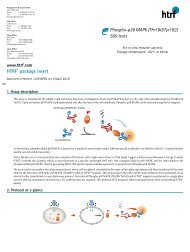

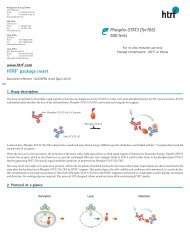
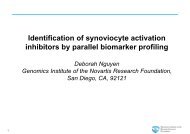
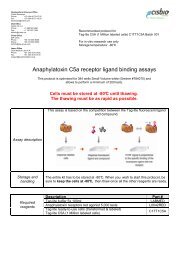
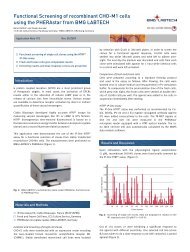
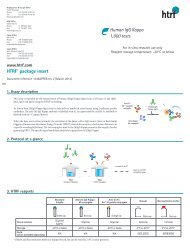
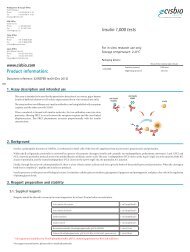
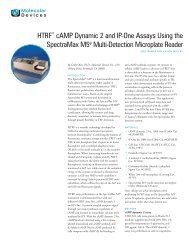

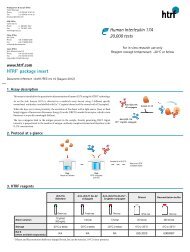

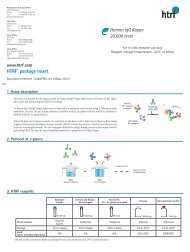
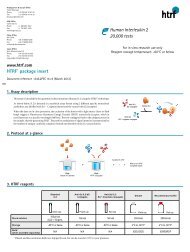
![HTRF meeting_130426_villa_pour pdf [Mode de compatibilité]](https://img.yumpu.com/22345646/1/190x135/htrf-meeting-130426-villa-pour-pdf-mode-de-compatibilitac.jpg?quality=85)